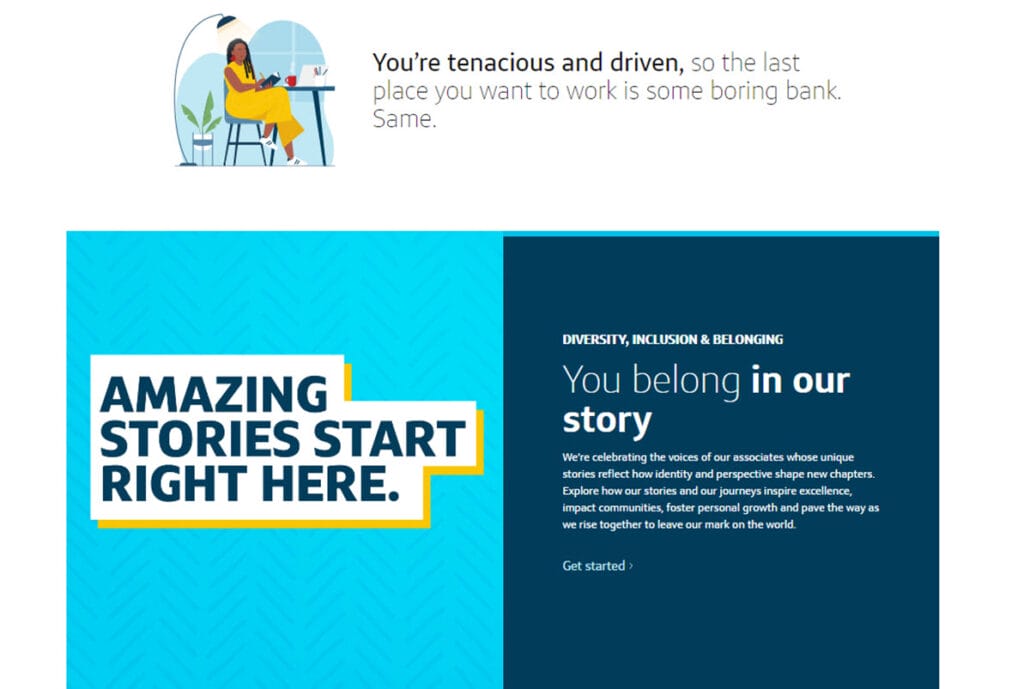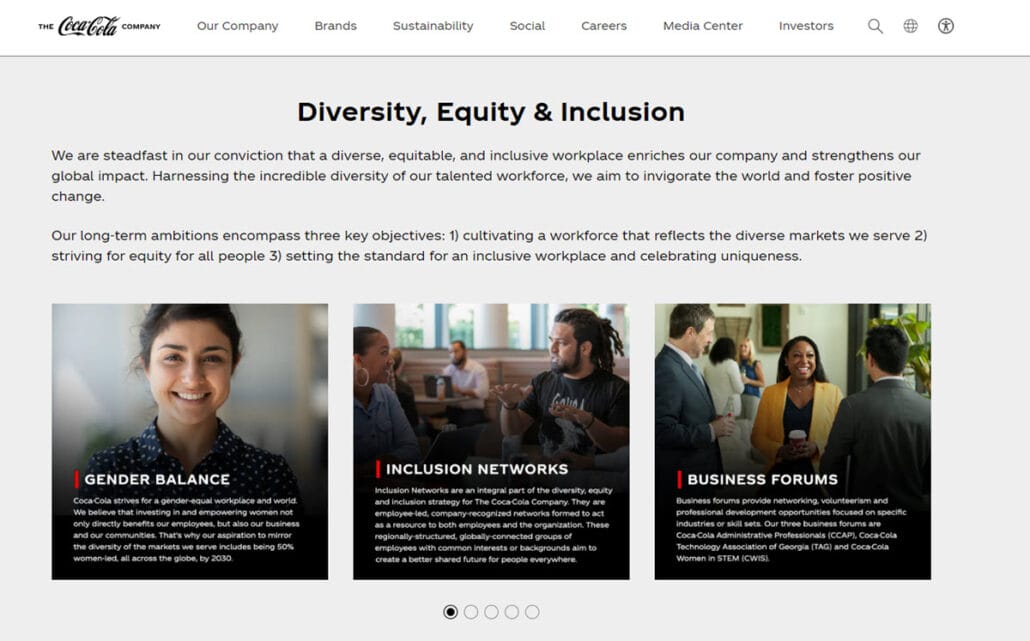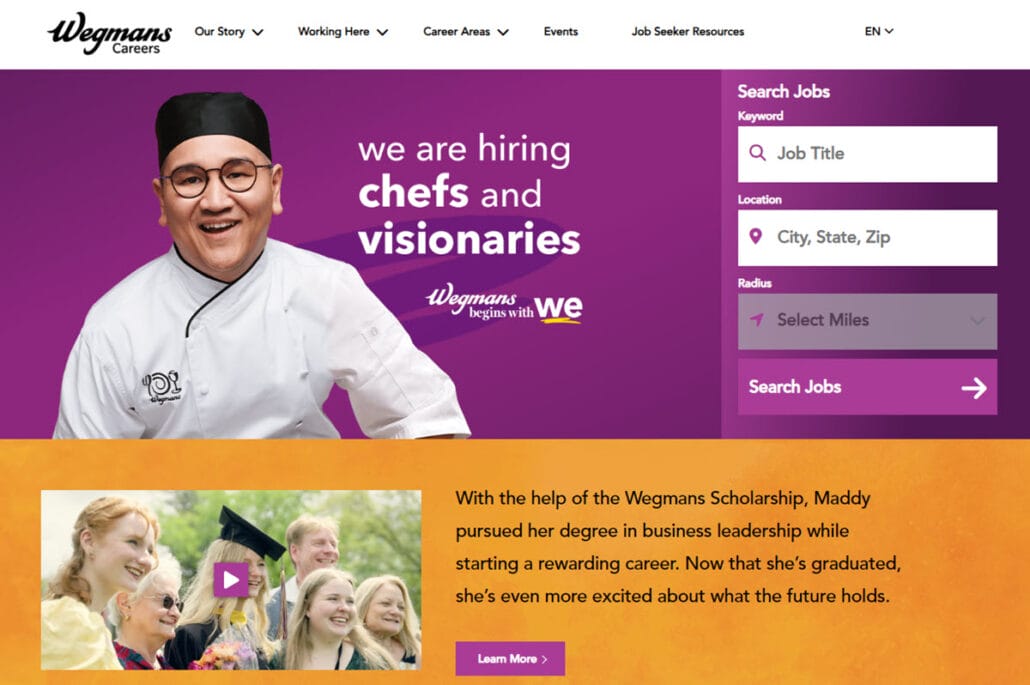Wondering how to attract top talent and retain valued employees? An effective employer brand strategy is the key. This guide will provide you with the tools and insights to build a strong employer brand that resonates with current employees and draws in quality candidates to keep your workforce engaged.
Key Takeaways
- A strong employer brand can attract top talent, reduce hiring costs, and improve employee retention by creating a positive workplace image and experience.
- Effective employer branding involves continuous refinement, honest and transparent communication, and a clear definition of the company’s unique value proposition, including its mission, values, vision, and culture.
- Employee involvement and consistent, authentic content across various platforms, such as social media, career pages, and internal communications, are crucial for fostering trust and amplifying the employer brand.
Understanding Employer Brand Strategy

In an era where the competition for talent is fierce, investing in employer branding has never been more critical. Employer branding is all about marketing your company to job seekers and internal employees, ensuring a positive image as a workplace. Employers who invest in their branding strategies not only attract new talent but also ensure long-term organizational success.
The goal of your employer branding strategy is to mold perceptions of your brand among employees and the broader market. It is an important plan for influencing the overall brand image.
For top-performing companies, employer branding strategy is seen as an ongoing endeavor. They continuously refine their approach to achieve better results. The best way to enhance your employer brand is to create positive candidate and employee experiences. Identifying your company’s unique value proposition – encompassing its mission, values, vision, and culture – marks the initial step towards constructing a potent employer brand.
Developing and managing a clear employer branding strategy can supercharge your talent acquisition efforts and improve retention.
Employer Branding Strategy Overview

Employer branding is a multifaceted strategy. At its core is grasping your company’s unique value proposition as you construct a robust employer brand. This proposition should focus on your company mission, values, vision, and culture—the elements that make your organization unique.
When refining your employer branding strategy, it is necessary to coordinate with the marketing goals of your organization. This could mean working with the marketing team, or if your company is smaller, consulting (or creating) brand guidelines. Ensure alignment with your company’s digital assets in all correspendence. Your career page, company news, social media channels, and even your email signature, are all platforms where your employer brand will shine.
Implementing a strong employer branding strategy requires transparency, honesty, and genuineness to build trust with employees and job seekers. Regularly collecting data from employer review sites helps monitor the employer brand experience and make necessary improvements.
An audit of your existing employer brand is an indispensable part of maintaining your brand. This involves:
- Understanding the current perceptions among employees and job seekers
- Refining your recruitment and selection process to improve the hiring experience
- Setting clear goals and getting leadership support
- Developing a strong employer branding strategy that positively changes the dialogue surrounding your company.
A powerful employer brand can provide myriad benefits.
Key Benefits of a Strong Employer Brand

A robust employer brand brings a variety of benefits like attracting premier talent, curbing hiring costs, and bolstering employee retention. By supercharging talent acquisition efforts and improving retention, a compelling employer branding strategy can significantly boost your company’s overall reputation.
The brand of an employer is considered by job seekers before each application, and shared values guide employees in choosing their next workplace. By having a strong employer brand, you ensure that your organization stands out in a competitive job market.
Attracting Top Talent
Premier talent is drawn towards a robust employer brand. With 86% of job seekers reading company reviews before applying, your brand’s reputation plays a crucial role in attracting qualified applicants. The brand of an employer is considered by job seekers before applying, and shared values guide employees in choosing workplaces. When candidates are deciding between multiple job offers, they are more likely to choose a company with a well built employer brand.
Demonstrating a genuine commitment to diversity, equity, and inclusion (DEI) initiatives also attracts top talent and positions your company as an employer of choice. Employee referrals, which are more common in companies with strong employer brands, can significantly expedite the hiring process and bring in high-quality candidates.
Reducing Hiring Costs
An influential employer brand has the dual advantage of drawing in more job candidates and reducing hiring costs. According to LinkedIn, strong employer branding can reduce cost per hire by up to 50%. A robust talent pipeline reduces the need to attract new applicants, cutting down overall recruitment costs.
Job agencies can testify to the importance of branding by comparing the number of job applicants they receive from ads that contain the name of highly branded companies. They receive as many as 4 times more applicants for ads displaying a well-branded company. Keeping those ads up for as long as possible can significantly expand their applicant base, whether the job seeker eventually gets that job or similar one they have open.
Employee referrals, which are higher in companies with strong employer brands, help find top talent quickly and cost-effectively.
Enhancing Employee Retention
Employee retention is significantly improved by a positive employer brand, as it fosters a sense of value and engagement among employees in their workplace. Some strategies to improve employee retention include:
- Offering learning and development opportunities to keep employees challenged and engaged
- Recognizing and appreciating employees’ efforts and achievements
- Providing a positive work environment and culture
- Offering competitive compensation and benefits
- Providing opportunities for career growth and advancement
- Soliciting employee feedback and responding appropriately
- Usung social media to recognize special events for each employee
When employee morale is high and their efforts are appreciated, they are more likely to stay with the company, reducing turnover. They’ll also have better feedback about working for the organization, both inside and outside of work, propelling the cycle of building a positive brand reputation.
SoulCycle, a popular fitness company, offers unique employee benefits such as paid days off for volunteering and internal development opportunities, initiatives that have been successful in increasing engagement and enhancing retention.
There are easy, no-cost way to recognize employees and improve branding at the same time. For instance, announce employee work anniversaries on social media to show longevity, or wish them a happy birthday through your internal network to them help celebrate and show you care. Depending on your organization’s size and culture, small gestures that build employee morale and enhance retention can have a large, positive effect on employer branding.
By prioritizing employee wellbeing through various benefits, you can nurture happier employees who are more likely to recommend your company as a great place to work. Low employee turnover due to strong employer branding also positively impacts the company’s financial health.
Building Your Employer Value Proposition (EVP)

An Employee Value Proposition (EVP) comprises the benefits and rewards extended to employees by an organization. The first step to creating a compelling EVP is to examine existing offerings, including compensation, benefits, and other perks and initiatives that reflect the company’s culture.
Collect data from employees through satisfaction, engagement, stay, and exit surveys to understand what parts of the EVP they value most at work. Review employee EVP feedback from survey data, and seek out ways to align what employees value with the company’s strategic business goals.
Define your EVP by clearly articulating the unique benefits and value that employees can expect from working at your company, based on feedback and what you can actually offer. Then, communicate the EVP clearly across all organizational levels using various channels like social media, email, and the company website.
Be sure to regularly review and update the EVP to ensure it remains relevant and aligns with employee expectations and market conditions.
A strong EVP has the power to attract and retain top talent. It can also assist in prioritizing company goals and agendas while reengaging a passionate workforce and lowering costs during the hiring process.
By defining your employer value proposition to reflect your company’s:
- Vision
- Purpose
- Culture
- Benefits
- Opportunities
You can create a compelling EVP that resonates with both current and prospective employees.
Conducting an Employer Brand Audit
An employer brand audit can reveal the prevailing perceptions of employees and job seekers. As part of your employer branding strategy, you should audit your existing employer brand. This involves methods like:
- Internal surveys
- Social media searches
- Monitoring career sites for reviews
- Hiring a firm that monitors reputation
Employer review sites can also be a great resource in providing insights into company ratings and reviews. Some popular sites include:
- Glassdoor
- CareerBliss
- Comparably
- Indeed
- Simply Hired
By understanding what influences potential applicants’ perceptions of the company and its competitors, you can target your employer branding initiatives for better results.
Reviewing trends among competitors can also help to identify gaps and opportunities in employer branding. Be sure to review competitor brands during your audit to uncover any areas your brand may be lacking.
Crafting Your Employer Branding Content

Effective storytelling is vital for forging a robust employer brand. Various channels such as the company website, videos, blog posts, social media, and newsletters help tell your company story effectively and showcase your company culture and values.
Defining candidate and employee personas makes it easier to decide what kind of employer branding content should be created and which channels should promote this content. This makes branding campaigns more personalized and efficient, and maximizes the use of storytelling.
Let’s take a look at the kind of content that can help establish a consistent, desirable employer brand across a variety of channels.
Utilize Employee Testimonials
Employee-generated content adds authenticity to your editorial calendar by providing real insights into company culture. Ensuring that employees are on board with sharing their views is necessary, but for those who agree, their perceptions can foster considerable trust and goodwill.
Obtain testimonials through employee interviews, review sites, or other internal methods to create social media posts or build out a more effective careers page. Take it a step further by conducting video interviews for more engaging visual testimonials.
Employee testimonials will affirm the employer brand and consistently communicate the employee value proposition to current employees, helping to retain and engage them.
Create Compelling Videos and Blog Posts
Creating compelling videos is a powerful step in developing a successful employer branding strategy; it allows companies to visually and verbally showcase their culture and values, making it easier for potential candidates to connect with the company’s story. Companies like Google, Duke University, and even YouTube itself use videos to highlight employee testimonials and showcase the company’s culture.
Blogs can also be used to strengthen employer brand by providing an in-depth look at the workplace culture, company values, and employee experiences. Some employees may even jump at the chance to write or be featured in a blog post.
You can leverage your company blog for employer branding by covering topics such as:
- employee time off
- hybrid meetups
- new product performance
- staff milestones
- humorous incidents at work
By creating content that resonates with both prospective and existing employees, you can effectively convey your company values, story, and culture.
Promoting Your Employer Brand
Now that you have your content ready, it’s time to leverage a variety of channels to reach and engage with your target audience. Use videos, photos, slideshows, blogs, and other messaging forms to tell your company story and reach a large audience.
Relevant channels for promoting your employer brand include your careers page, paid ads, videos, blog posts, podcasts, photos, and social media channels. For major news, creating a press release and submitting it to various PR channels can spread the news, and your employer brand, to an even larger audience.
The choice of channels and formats should be influenced by the target audience and ideal candidate persona. Tracking social engagement metrics such as likes, shares, and followers helps measure employer brand exposure. Always ensure that the content posted and shared for employer branding is of high quality and reflects the brand as intended.
Leveraging Social Media Channels
Social media is a powerful tool for employer branding.
LinkedIn is a fantastic platform for connecting with active and passive candidates at all points in their career journey. It provides a wide range of opportunities to engage with professionals at different stages of their careers.
Other Social Media platforms your company might consider based on the company culture include:
- Twitter (X)
- YouTube
- SnapChat
- TikTok
Transparency is vital for building real trust and loyalty with the audience. Engaging with potential candidates on social media and responding to reviews helps build trust and amplify the employer brand. Nothing is worse for your company’s reputation than to leave a publicly-asked question unanswered. Not only the potential applicant, but all potential employees that see the lack of response will form an unfavorable impression.
Ensuring consistent messaging is another key to effective employer branding. A good editorial calendar helps keep messages consistent and allows you to proactively plan content for social media channels. Platforms like Zoho Social integrate with various channels to schedule consistent posting on various channels.
Meanwhile, creative design platforms like Canva offer an employer branding asset library to maintain consistency across various campaigns. Creative copy and design can increase the number of applicants by up to 50%, so keep working on this effort.
Optimizing Your Careers Page
Your careers page is often the first point of contact for job seekers, making it a critical component of your employer branding strategy. While your company or marketing department policies may restrict you from making the career page exactly the way you’d like, be sure to nurture the relationship between those that make the website content rules. Then explain the ‘why’ in adding your desired content, and be willing to negotiate a middle ground.
Make your employer brand stand out by sharing what makes your company unique. Highlight the company culture through blog posts, videos, and testimonials from satisfied employees, and share stories of community involvement that reflect the organization’s culture surrounding corporate and social responsibility. Then, integrate all of these elements on your careers page to create a true showcase of the company brand.
A necessary element of a careers page, job postings should accurately reflect what it’s like to work in your organization. This will help attract the right talent and align their values and behaviors with those of the company. You might also consider describing a day in the life of an employee and discuss the projects earmarked for the role.
Tableau enhanced their careers page by:
- Empowering employees to create data visualizations aligned with personal interests
- Providing a behind-the-scenes look at team personality
- Leveraging their product for background information
Finally, if you post individual job openings on your website, there are ways to entice them to display on Google Careers at no cost. By adding specific information to each job description page, along with schema markup code behind the scenes, your job openings have an excellent chance for attaining this high visibility. Consider outsourcing your site’s schema markup to a digital marketing agency that is experienced with its implementation. You’ll be way ahead of competitors who don’t use this strategy.
Engaging Employees in Employer Branding Initiatives
Employee engagement in employer brand initiatives is key to fostering trust and credibility. The employer brand greatly depends on existing employees, as candidates are three times more likely to trust employees than employers for an accurate representation of the organization. This emphasizes the importance of showcasing the experiences and perspectives of current and former employees.
It’s important for team members to:
- Share their experience of working at the company on social media
- Share their experience through employer reviews
- Share their experience while networking
Obviously, it’s critical to ensure their experiences they share are positive ones!
This type of sharing helps to build trust among the community. Employee-generated content can be shared on social media posts, stories, career sites, YouTube videos, and other channels to benefit employer branding.
Leadership buy-in is crucial for employer branding initiatives, and engaging the C-suite is key to supporting these initiatives. Top-down support from leadership can include:
- Active participation in social media and internal communications
- Offering employer brand training opportunities
- Organizing launch events
- Starting an employee ambassador program
- Creating a referral program
Strong internal communication helps ensure employees are on the same page and can involve sharing posts and content on various channels. Employers use employee advocacy solutions to cultivate an influential brand. This is achieved by empowering employees to share their perspectives and experiences. Leveraging current employees as advocates helps build strong employer branding as they are seen as credible sources.
Measuring Employer Branding Success
Establishing clear goals should be a priority in every employer branding strategy. This will enable organizations to effectively make the case for employer branding and measure its impact.
Selecting relevant metrics for each goal is key to tracking progress effectively. KPIs serve as quantifiable measurements for assessing the achievement of a specific goal or objective. Calculating the ROI of employer branding involves comparing initiative costs with KPIs and other business benefits like improved retention.
KPIs are essential for analyzing and managing performance. Factors including the number of applicants received, responses per job opening, and the percentage of positive responses after direct approach can be used to measure applicant quantity.
HR tools that can assist in monitoring progress include:
- Applicant tracking systems (ATS)
- Human resources information systems (HRIS)
- Google Analytics
- The finance team
- Data and analytics specialists
The Employer Brand Index (EBI) measures employees’ perceptions across multiple brand attributes, helping to assign quantifiable data to your company’s reputation among employees.
By analyzing the success of your employer brand strategy, you can fine-tune the plan and set new goals.
Case Studies for Successful Employer Branding
Real-life examples of successful employer branding that are documented in case studies can provide valuable insights and inspiration. Here are some examples.
Capital One was named one of the top 100 best places to work in 2024 by Glassdoor. The company’s youthful brand and commitment to employee wellbeing and individual identities is evident on its career website, which features a blog highlighting stories and experiences of employees at the company.

Coca-Cola’s career page features a variety of content surrounding workplace culture that humanizes the brand. By sharing real stories from employees, Coca-Cola has created a positive and engaging employer brand that attracts top talent.

Maddy’s story at Wegmans, where she received support from the Wegmans Scholarship to pursue a degree in business leadership while building her career, demonstrates the impact of strong employer branding on employee growth and satisfaction.

Finally, Plante Moran offers opportunities for career growth through internships and full-time careers to help individuals deepen their expertise and broaden their skills. This strategy earned the company multiple awards including Fortune’s top 100 places to work in the US.
These case study-type instances underscore the significance of investing in employer branding initiatives to foster an engaging and positive workplace culture. Their interesting topics and company goodwill jump out and grab the reader, making them want to apply even if they’re not looking for a job at the moment.
Summary
In summary, mastering an employer branding strategy involves understanding its core components, building a compelling Employer Value Proposition (EVP), conducting a thorough brand audit, and crafting engaging content. By promoting your brand through various channels and engaging employees in branding initiatives, you can create a positive and attractive employer brand that resonates with job seekers and employees alike. Setting clear goals and selecting relevant metrics to track progress is crucial for measuring the success of your employer branding efforts.
Investing in employer branding is not just about enhancing the recruitment process; it’s about creating a workplace culture that values and engages employees, leading to higher retention rates and overall organizational success. By following the steps outlined in this guide, you can build a solid employer branding strategy today that stands out in the competitive job market and inspires others to join your organization.
Frequently Asked Questions
What is an employer branding strategy?
An employer branding strategy involves marketing your company to attract job seekers during the recruitment process, and shapes the perception of your company as a desirable workplace for current and prospective new employees.
How can employer branding reduce hiring costs?
Having a well built employer brand can decrease hiring and recruitment costs significantly by attracting more job candidates and reducing the cost per hire by up to 50%.
Why is it important to engage employees in employer branding initiatives?
Engaging employees in employer branding initiatives is important because it can increase trust in the workplace and make external communications more credible and attractive to job seekers. It fosters a positive image of the company and improves its overall reputation.
What methods can be used to conduct an employer brand audit?
You can conduct an employer brand audit by using methods such as candidate and employee surveys, internet and social media searches, and reputation monitoring firms. These methods provide valuable insights into your employer brand’s perception and reputation among potential and current employees.
What are the signs of a successful employer branding strategy?
You can measure the success of your branding strategy by clearly defining goals, selecting relevant metrics, and using tools like applicant tracking systems and human resources information systems to track progress. This will provide valuable insights and help assess the effectiveness of your strategy.


